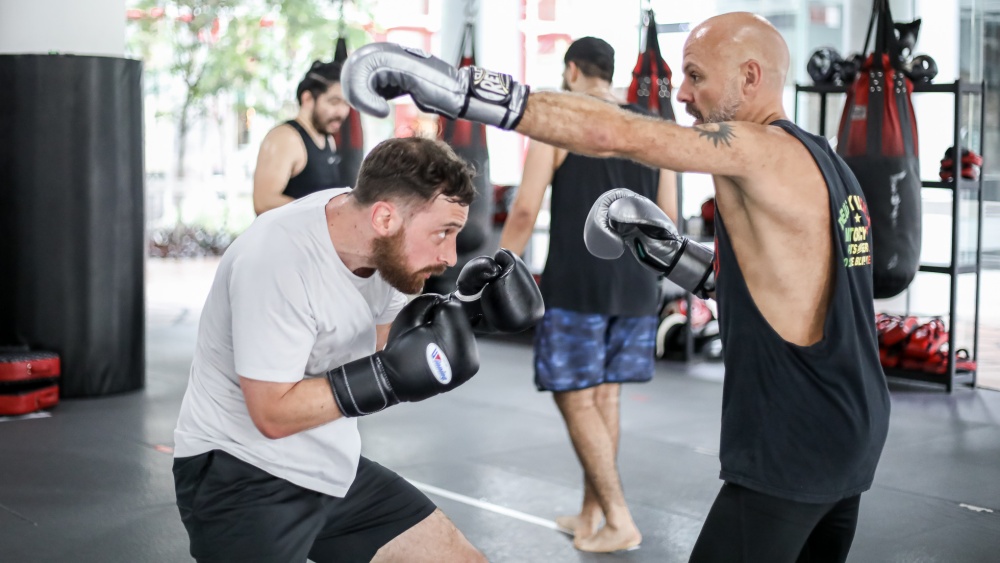The high guard is the most common defense used in boxing today. It’s not just popularly used among beginners, but also world champion boxers. Its prevalence in the modern era of boxing has led to the discontinuation of other styles of defense, such as the cross-arm guard. The cross-arm guard is a powerful defense that involves crossing your arms over each other and folding them close to protect your body and chin.
While the exact origins of the cross-arm guard are murky, it is clear that its roots are in bare-knuckle boxing. The Art And Practice Of Boxing, a manuscript written in 1825 by the anonymous Celebrated Boxer, also describes the technique of barring, which is essentially the top half of a crossguard. Other manuals from the same era detail the cross-arm guard as being particularly effective at blocking multiple blows, in other words, punch combinations.
Unfortunately, as time goes, the crossguard became abandoned because of simpler techniques such as the high guard. The cross-arm guard, though powerful, has many intricacies. One of which is the longer learning time. The boxers who do commit to the cross-arm style, are known for their slickness and proficiency in the ring. Today, Evolve Daily will share how to add the cross-arm guard to your boxing game.
Advantages
Like any technique, the cross-arm guard has its advantages and disadvantages. Knowledge of its strengths and weaknesses will make it an even more powerful tool. However, you must also understand when to use it and when to switch to other forms of defense. The first advantage to the cross-arm guard is the level of protection to your chin and head. You take lesser damage from your opponent’s blows as there are very few gaps in the guard.
The next advantage the cross-arm guard offers is an unobstructed field of view. With a high guard, your peripheral vision is all but gone. The same is not true for the cross-arm guard since your arms are horizontal across your chin, leaving your eyes clear to see and react to counters.
Another advantage is that the cross-arm guard provides both offense and defense. Punches thrown with any power can easily result in a broken hand as the elbow is the bone with the highest density in the human body. Many defensive masters such as Floyd Mayweather and Canelo Alvarez use this technique to great effect. This makes their opponent hesitant to throw power punches to avoid hurting themselves. You can also use the cross-arm guard to counter your opponent’s counter. An example would be your opponent looking to counter with their left hook after throwing your right cross. Cross guarding right after throwing your right cross would result in your opponent’s left hook meeting the tip of your right elbow instead of your chin.
Disadvantages
One of the disadvantages of the cross-arm guard is that it leaves you somewhat vulnerable to body shots. Though crossing your arm would form a shell around your chin, protects your head, it leaves you with nothing to protect your body. This is mitigated by bending at the waist and using head and body movement. The Michigan Crab, also known as the Mayweather style, is an offshoot of the cross-arm guard that sacrifices offensive capabilities while simultaneously guarding the head and body.
Another disadvantage of the style is the lack of coaches that teach it. Only a handful of boxers were able to achieve mastery of this guard in the past century. This is due to the lack of knowledge within the boxing world on how to use it.
Basic Stance
The cross-arm guard for an orthodox boxer has their right arm crossed over their left arm, with the right hand over the left shoulder, and the left hand under the right tricep. Watch Coach Tom Yankello break it down with his student.
- An opponent’s orthodox jab is blocked by either the right elbow or forearm.
- A right cross can be blocked with the right forearm and palm, or by lifting your left elbow to meet the punch.
- The left hook can be caught with the left palm crossed under your right tricep, or by lifting your right elbow to intercept the blow.
This system changes depending on whether you and your opponent have an open or closed stance, but the same basic principles apply. You can defend blows to your right side with your right elbow, right shoulder, and left hand. The same goes for attacks aimed at your left side, you can defend with your left elbow, left shoulder, or right hand.
Offensive Opportunities
Although learning to punch with the cross-arm guard can be difficult initially, practice will make you a master at countering your opponent’s punches. Blocking your opponent’s punches requires you to put weight onto your front foot, loading your lead hand for a counter hook. This is the exact technique Joe Frazier used to knock down Muhammad Ali! The cross-arm guard also gives you the confidence to throw hard shots without eating a counter. Skip to 6:16 to watch as Canelo Alvarez lifts his elbow to shut down his opponent’s counter after landing a punch with his lead hand.
Training The Cross Arm Guard
The key to improving the cross-arm guard, is practice. Technical sparring with a partner using the high guard is the most practical way of applying the cross guard to an actual fight. However, if you aren’t able to train with a partner, there are various ways of training by yourself through means such as shadowboxing, heavy bag training, and of course by watching films. Watch the demonstration by Precision Striking on how to practice the cross-arm guard with a partner.
Final Thoughts
The cross-arm guard is a powerful weapon to add to your toolbox of techniques. Although it requires much practice to master, learning the cross-arm guard will elevate your boxing game to a level that few can match.
You may also like:

















